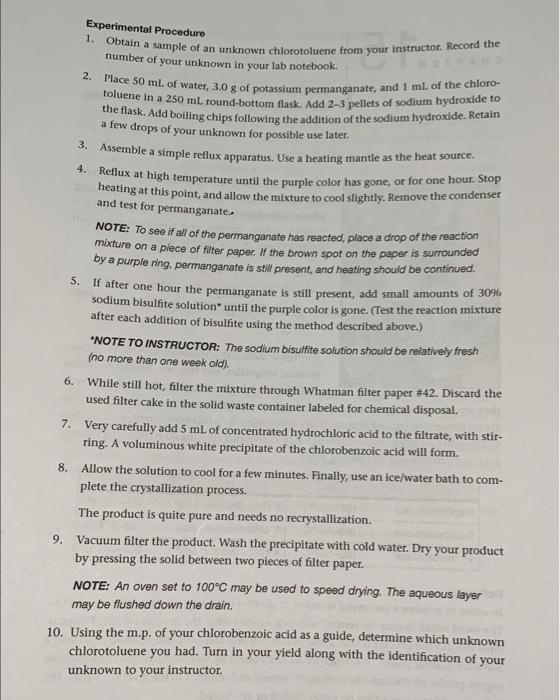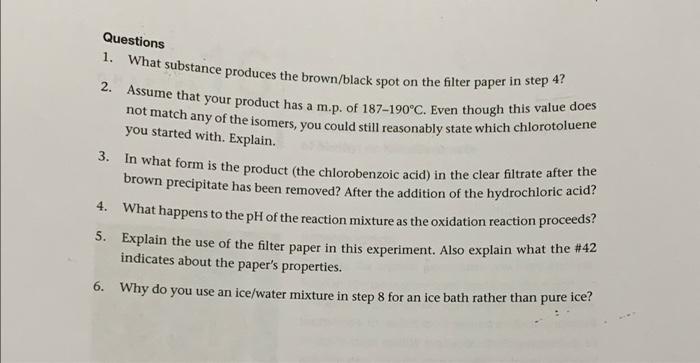Answered step by step
Verified Expert Solution
Question
1 Approved Answer
please answer step #10 as well as aquestions 1 through 6 Experimental Procedure 1. number of your unknown in your lab notebook 2. Place 50
please answer step #10 as well as aquestions 1 through 6 


Experimental Procedure 1. number of your unknown in your lab notebook 2. Place 50 ml of water, 3.0 g of potassium permanganate, and I mL of the chloro- Obtain a sample of an unknown chlorotoluene from your instructor. Record the toluene In a 250 ml round-bottom flask. Add 2-3 pellets of sodium hydroxide to the flask. Add boiling chips following the addition of the sodium hydroxide. Retain a few drops of your unknown for possible use later. 3. Assemble a simple reflux apparatus. Use a heating mantle as the heat source. Reflux at high temperature until the purple color has gone, or for one hour. Stop heating at this point, and allow the mixture to cool slightly. Remove the condenser 4. and test for permanganate. 5. NOTE: To see if all of the permanganate has reacted place a drop of the reaction mixture on a piece of filter paper. If the brown spot on the paper is surrounded by a purple ring, permanganate is still present, and heating should be continued. If after one hour the permanganate is still present, add small amounts of 30% sodium bisulfite solution until the purple color is gone. (Test the reaction mixture after each addition of bisulfite using the method described above.) *NOTE TO INSTRUCTOR: The sodium bisulfite solution should be relatively fresh (no more than one week old), 6. While still hot, filter the mixture through Whatman filter paper #42. Discard the used filter cake in the solid waste container labeled for chemical disposal. 7. Very carefully add 5 mL of concentrated hydrochloric acid to the filtrate, with stir- ring. A voluminous white precipitate of the chlorobenzoic acid will form. 8. Allow the solution to cool for a few minutes. Finally, use an ice/water bath to com- plete the crystallization process. The product is quite pure and needs no recrystallization. 9. Vacuum filter the product. Wash the precipitate with cold water. Dry your product by pressing the solid between two pieces of filter paper. NOTE: An oven set to 100C may be used to speed drying. The aqueous layer may be flushed down the drain. 10. Using the m.p. of your chlorobenzoic acid as a guide, determine which unknown chlorotoluene you had. Turn in your yield along with the identification of your unknown to your instructor. Questions 1. What substance produces the brown/black spot on the filter paper in step 4? 2. Assume that your product has a m.p. of 187-190C. Even though this value does not match any of the isomers, you could still reasonably state which chlorotoluene you started with. Explain. 3. In what form is the product (the chlorobenzoic acid) in the clear filtrate after the brown precipitate has been removed? After the addition of the hydrochloric acid? 4. What happens to the pH of the reaction mixture as the oxidation reaction proceeds? 5. Explain the use of the filter paper in this experiment. Also explain what the #42 indicates about the paper's properties. 6. Why do you use an ice/water mixture in step 8 for an ice bath rather than pure ice? Data/Results/Calculations: Unknown #6 Filter paper by itself: 0,228 g Filter paper with crystals: 0,677 g Melting point: 200C-220C Y 


Step by Step Solution
There are 3 Steps involved in it
Step: 1

Get Instant Access to Expert-Tailored Solutions
See step-by-step solutions with expert insights and AI powered tools for academic success
Step: 2

Step: 3

Ace Your Homework with AI
Get the answers you need in no time with our AI-driven, step-by-step assistance
Get Started


